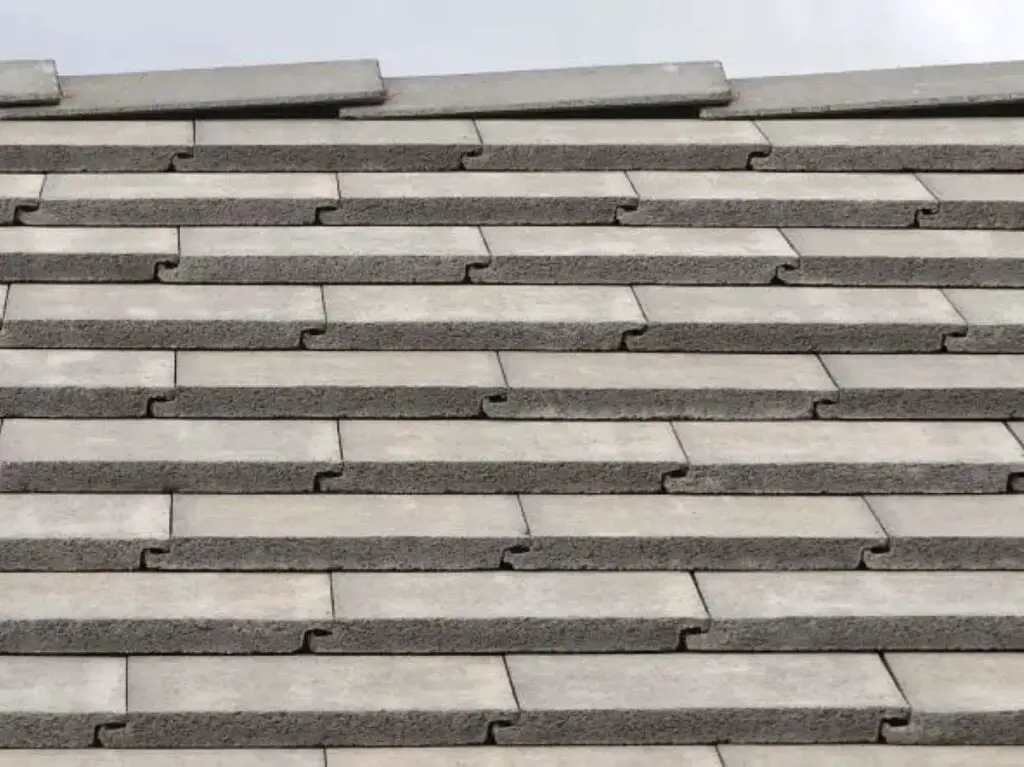Also see: Roof Cost Calculator
Table of Contents

Introduction
In this article, I’m going to explain the factors that determine clay and concrete tile roof costs. I’ll also give you the typical costs for various types of tile roofs in 2025.
Keep in mind that the cost of any particular tile roof will depend on several variables, including roof size, roof pitch, roof complexity, local labor costs, and the style, weight, and material of the tile itself. Shipping and handling can also add significantly to the cost, especially for thicker, heavier tiles or imported clay products. On average, the cost of a clay or concrete tile roof replacement in 2025 ranges from $11.20 per square foot for basic concrete tiles to $18.50 per square foot for premium clay tiles.
For an average 1,700-square-foot roof, this puts the national average cost of a tile roof between $19,000 and $31,000, depending on the type of tile selected.
Also see my Roof Replacement Cost Guide, which has typical current roof prices for other residential and commercial roofing materials.
Note on Average Roof Size
A precise value for the average roof size for existing (not just new construction!) U.S. single-family homes is not directly available from any official source. I used publicly available data for average home square footage and the percentage of 1-story versus 2-story homes, as well as adjusting for typical eave overhangs and the average roof pitch multiplier, to estimate an average U.S. roof size of a little under 1,700 square feet.
Clay and Concrete Tile Roof Cost in 2025
These cost estimates should be fairly accurate; I try to keep them reasonably up-to-date using current or recent material prices and labor data. Keep in mind that the costs listed below are national averages, and actual costs can vary significantly depending on location. To get a more accurate idea of what a new tile roof will cost in your area, see “Relative Construction Costs by U.S. State” and apply your state multiplier to the national average cost.
Shipping costs can have a significant impact on material prices, especially in states that are far from manufacturing plants. Clay and concrete tiles are both very heavy and very bulky compared to other roofing materials, so freight charges can noticeably raise prices in areas without a nearby supplier.
The tile roof cost estimates given below assume a roof pitch of 6/12 or less and include removal of the existing roof and installation of all standard tile roof components, such as underlayment, batten systems, flashings, and ridge caps. Roofs with steeper pitches or more complex designs can increase labor costs by as much as 50%, particularly with heavy materials like roof tile.
Table: Tile Roof Cost per Square Foot
Cost estimates for metal tiles and synthetic composite tiles are included so you can compare prices if you want. See my Metal Roof Cost Guide and Shingle Roof Cost Guide for more detailed information on these materials.
| Average Cost of a Tile Roof | |||
|---|---|---|---|
| Roof Tile Type | Average Installed Cost Per Square Foot |
Average Installed Cost Per Square (100 sq. ft.) |
Average Installed Cost Average Roof (1700 sq. ft.) |
| Clay Tile Flat Profile (Shingle Style) |
$15.40 | $1,540 | $26,180 |
| Clay Tile Mission (2 Piece) |
$16.30 | $1,630 | $27,710 |
| Clay Tile S-Profile (1 Piece) |
$14.70 | $1,470 | $24,990 |
| Clay Tile Premium Styles |
$18.50 | $1,850 | $31,450 |
| Concrete Tile Flat Profile (Shingle Style) |
$11.70 | $1,170 | $19,890 |
| Concrete Tile S-Profile (1 Piece) |
$11.20 | $1,120 | $19,040 |
| Concrete Tile Premium Styles |
$14.00 | $1,400 | $23,800 |
| Lightweight Concrete Flat Tile (Shingle Style) |
$12.20 | $1,220 | $20,740 |
| Lightweight Concrete S-Shaped Tile |
$11.70 | $1,170 | $19,890 |
| Metal Tile Steel, Premium Coating |
$13.10 | $1,310 | $22,270 |
| Synthetic Composite Tile (Engineered Polymeric Tile) |
$12.60 | $1,260 | $21,420 |
Types of Clay and Concrete Roof Tiles
Tile roofing includes any roof system that uses individual clay or concrete tiles as the primary roof covering. These systems are installed over a sloped roof deck (minimum allowed slope for a tile roof is 2½-in-12) with an underlayment, and often a batten system (depending on tile type, regional climate, and wind uplift requirements). Roof tiles can be individually fastened with nails, screws, hooks, or even polyurethane foam adhesive; the exact installation method will depend on the manufacturer and/or specifier, with consideration for tile profile, tile material, the slope of the roof, and local code requirements.
Both clay and concrete tiles provide excellent durability, fire resistance, and weather protection. Clay tiles are especially valued for their long service life and ability to hold their color without fading over time. Clay tile roofs often last over 75 years when installed correctly, while concrete tiles typically offer a service life of 40 to 60 years. Concrete tile is generally less expensive than clay and can be manufactured in similar profiles and colors, although it is heavier and more porous, which may lead to higher water absorption rates over time.
Most roof tile manufacturers offer several different tile profiles, each with its own appearance and performance characteristics. Below are the main categories of clay and concrete tiles used in residential roofing.
Flat Tile (Flat Profile or Shingle Style)
Flat tiles are produced in both interlocking and overlapping styles, with rectangular shapes that form a smooth, planar surface when installed. Whether made of clay or concrete, these tiles are often molded to resemble wood shakes or slate. Like other shingles, the tiles are laid out in horizontal courses that overlap to shed water. Flat tiles may also feature micro-interlocks to improve wind uplift resistance and make layout easier.
Clay flat tiles generally weigh less and offer long-lasting natural color options. Concrete flat tiles are more cost-effective and structurally consistent, and they can be manufactured in a wide range of colors using pigments added to the mix or applied to the surface. However, because concrete is more porous, its color can fade over time and the tiles may require periodic cleaning or sealing to maintain their appearance.
Mission Tile (Two-Piece Barrel)
Mission tile is the traditional two-piece barrel tile system, consisting of a curved top piece (the “cap”) and a corresponding curved bottom piece (the “pan”). This is one of the oldest and most recognizable tile roofing systems. The curved shape channels water effectively and encourages ventilation beneath the tiles, which helps reduce heat buildup on the roof deck in warm climates.
Mission tile requires skilled labor to install, and because it uses a two-piece system, both material and labor costs tend to be higher than with one-piece systems. Clay is the traditional material for mission tiles and remains the preferred choice for high-end and historical applications. Concrete versions exist but are heavier and not always true reproductions of classic mission profiles.
S-Profile Tile (Spanish Style, One-Piece Barrel)
S-profile tiles, also known as Spanish tiles or pantiles, are a single-piece tile with an S-shaped curve that creates alternating ridges and valleys across the roof surface. This design mimics the appearance of mission tile but with less material and labor required for installation. These tiles provide effective water shedding and a distinctive contour that is well-suited to Mediterranean, Spanish, or Southwestern architectural styles.
S-profile tiles are made in both clay and concrete variants. Clay S-tiles often have richer, more permanent colors and are less prone to surface wear, while concrete S-tiles are heavier, more affordable, and available in a broad range of synthetic finishes. Installation of S-profile tiles requires careful alignment to ensure consistent patterning and prevent water intrusion.
Tile Roof Installation Cost Factors
The two biggest cost factors are labor and materials, but there are a few other things to take into account. Total costs for tile roofs generally break down to roughly 60% to 70% for labor and 30% to 40% for materials.
Compared to asphalt shingles, tile roofs have a higher proportion of labor costs because tile installation is more time-consuming and requires greater skill. The exact cost breakdown depends on the tile type and complexity of the roof, as well as regional labor rates.
Material Costs
Material costs for a tile roof depend primarily on the tile profile (flat, S-profile, or mission), the material (clay or concrete), and the brand or manufacturer. Clay tiles are typically more expensive than concrete tiles, especially if imported or handmade.
Material costs also include accessories such as eave closures (bird stop), ridge caps, hip starters, rake tiles, flashings, and underlayment. In some regions, batten systems or foam adhesives may also be required.
Shipping and Freight Costs
Shipping costs are an often overlooked factor in the total cost of a tile roof. Roof tiles are heavy and bulky compared to other roofing materials, and transportation charges can vary significantly depending on how far the materials must travel from the manufacturing plant to the job site.
In regions located far from major tile production hubs (Texas, Florida, California, and Arizona are the primary manufacturing centers in North America), freight charges can add substantially to the overall material cost. Shipping a full load of tile across long distances by truck can add hundreds of dollars per roofing square, especially in states without local suppliers or distributors.
Because freight pricing is based on weight, distance, fuel prices, and shipment size, smaller orders or partial truckloads often result in higher per-square shipping costs. In remote areas or high-cost regions, shipping can account for a meaningful percentage of the total roof price.
Labor Costs
Labor costs for tile roof installations are significantly higher than for asphalt shingles. Tile roofs must be carefully laid out, fastened, and cut to fit complex roof areas. Cutting roof tile on site is more involved than trimming asphalt shingles, as you can imagine. Installation methods will vary depending on local code and wind uplift requirements.
You can expect to pay more for labor in areas with a higher cost of living, and especially in states where union roofers dominate the commercial sector. Because of the skill and time involved, tile roof installation is one of the most labor-intensive types of residential roofing work.
Roof Complexity
As with any roof system, roof complexity has a major effect on total cost. Intersecting rooflines, hips, valleys, dormers, skylights, and chimneys all increase the number of cuts, layout adjustments, and flashing details required.
With tile roofing, these complexities increase both labor and material usage. Tiles must often be precisely cut, fastened, and sealed around penetrations. Some details require specialty trim tiles that are sold separately and add to material costs.
Roof Pitch (Steepness)
Roof pitch is another important factor. Steeper roofs take longer to install because they require additional safety measures and equipment. Workers may need to use roof jacks, harnesses, or scaffolding, and material staging becomes more difficult.
For roofs with a pitch over 6:12, labor costs can increase by as much as 30%, which can add 20% or more to the overall project cost.
Removal of Existing Roofing
A tile roof should not be installed over any existing roofing. Removing and disposing of the old roofing materials, including any previous tile system, shingles, underlayment, fasteners, and battens, typically adds $1.50 to $4.00 per square foot to the total cost. Keep in mind that removing and disposing of an old tile roof system will be much more expensive than getting rid of an old asphalt shingle roof. Costs may be higher if structural repairs or sheathing replacement is needed.
Local Taxes, Fees, and Permits
As with any roofing project, local regulations may add to the cost. This can include building permit fees, dumpster rental, debris disposal charges, and local or state construction taxes. These should be factored into the total project budget.

